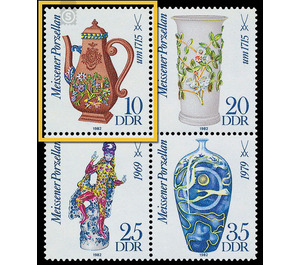Commemorative stamp series - Germany / German Democratic Republic 1982 - 10 Pfennig
Theme: Art & Culture
| Country | Germany / German Democratic Republic |
| Issue Date | 1982 |
| Face Value | 10.00 |
| Color | multi-colored |
| Perforation | K 14 |
| Printing Type | Rotogravure 2 |
| Stamp Type | Postage stamp |
| Item Type | Stamp |
| Chronological Issue Number | 2409 |
| Chronological Chapter | GER-DDR |
| SID | 396278 |
| In 12 Wishlists | |
On the occasion of the 300th birthday of Johann Friedrich Böttger in 1982 For the 300th birthday of Johann Friedrich Böttger in 1982, the Ministry of Posts and Telecommunications of the German Democratic Republic issued four multicolored special postage stamps in combination and a block with two multicolored special postage stamps. Special cancellation from January 26 to March 25, 1982 Böttger - Honoring the German Democratic Republic 1982 Dresden - Meissen On February 4, 1982, Johann Friedrich Böttger (1682-1719) celebrates his 300th birthday. In 1708 he found the recipe for the production of hard porcelain - the foundation for the founding of the Meissen Porcelain Manufactory. Böttger was appointed its first administrator and led her through the first years. It was important to outgrow the invention beyond the conditions of a laboratory and let it mature for series production. The merit Böttgers is supra-regional; he gave the porcelain to the world because he found the substances to be synthesized (kaolin + feldspar + quartz). Thus, the porcelain was detached from the bond to East Asian mineral resources, which offered the substances in the finished mixture. Its performance is therefore also the foundation for all porcelain production in the world. The abundance of these positives corresponds to the Council of Ministers of the German Democratic Republic also with his tribute Böttgers in February 1982. 10 Pfennig value: pot Synonym for the Böttger era is the bright red on brown to metallic gray-black fired Böttger stoneware. With progress in porcelain production since 1713, this material disappeared gradually, in which the white is replaced by the red-burning clay. The illustrated pot (Staatliche Kunstsammlungen Dresden), created around 1715, should be equal to or better than the East Asian porcelain, also testifies to the ingenuity of creating surface luxury products of the current need; here by relief, cut, polish, gemstone mounting and painting - for the time being by means of unvarnished paint colors.


